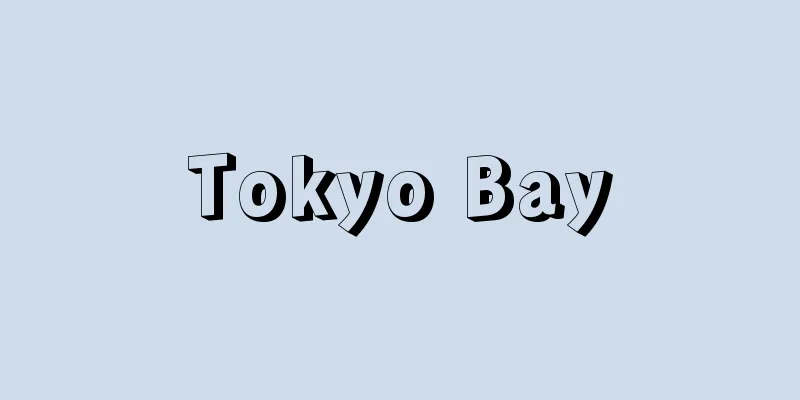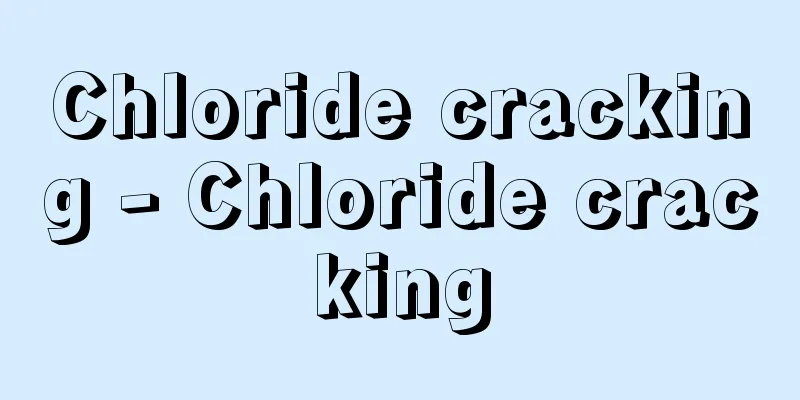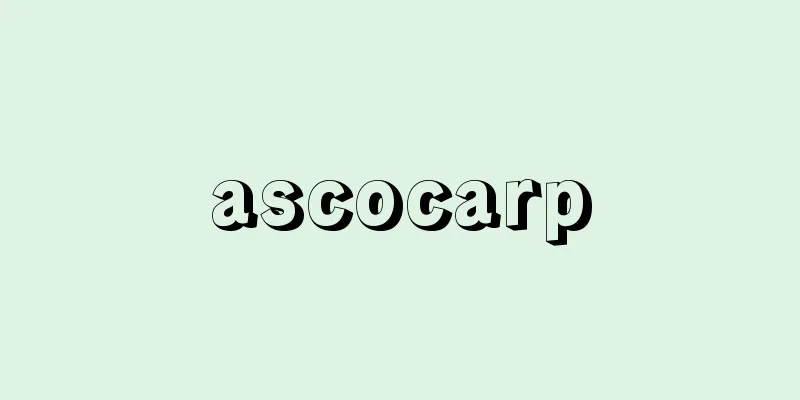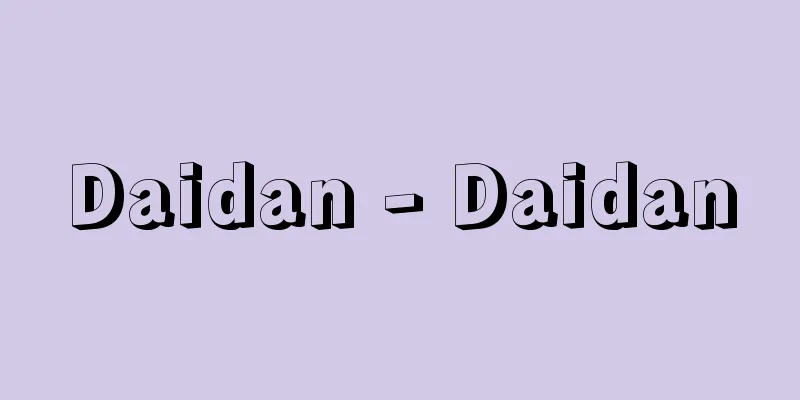Tokyo Bay

|
A bay on the Pacific coast in the southern Kanto region, surrounded by the Boso Peninsula and the Miura Peninsula. In a broad sense, it refers to the waters north of the line connecting Susaki on the western tip of the Boso Peninsula and Tsurugisaki on the Miura Peninsula, covering an area of about 1,500 square kilometers. In a narrow sense, however, it refers to the inner bay, covering an area of about 1,100 square kilometers, north of the line connecting Cape Futtsu and Katsurikizaki in Yokosuka City, excluding the Uraga Channel to the south. The western part of the bay belongs to Tokyo and Kanagawa Prefecture, and the eastern part belongs to Chiba Prefecture, but industry has developed around the capital Tokyo, forming Japan's largest Keihin Industrial Zone, and the bay is one of the world's leading trading port regions. It is also highly concentrated in population, making it an overcrowded area with a population of over 20 million. [Kiyoshi Sawada] terrainHalfway between Cape Futtsu and Cape Honmoku in Yokohama, called Nakanose, the water is about 20 meters deep, and north of this the water is less than 40 meters deep, with a simple undersea topography. As the coast is a diluvial plateau, wave erosion is strong, resulting in a deposit-based topography and a smooth coastline. Water less than 5 meters deep is sandy, and the shallow sea 1 to 2 kilometers offshore from the coastline, with a depth of 1 to 2 meters, was an ideal environment for cultivating shellfish and seaweed. Water less than 5 meters deep can easily be filled in using sand from the seabed, and today this has resulted in an artificial coastline with landfill work. On the other hand, the water is deep south of Cape Futtsu and Cape Honmoku, and there are two submarine canyons called the Kannonzaki Submarine Channel (Old Tokyo River) and the Tokyo Submarine Canyon, which are more than 40 meters deep, extending 100 meters off the coast of Kurihama and 1,000 meters into the bottom of Sagami Bay. A small submerged valley that merges with this valley forms a ria coast, and due to the Tertiary geology and the absence of large rivers, sedimentation has not progressed, resulting in an eroded topography. This natural inlet was used as a good port from early on, but today the artificial port on reclaimed land is more active. [Kiyoshi Sawada] Gulf Coast IndustryTokyo Bay was developed as a fishing area about 300 years ago, but fishing declined around the beginning of the Meiji era, and the area became a seaweed and shellfish farming area, and the coast became a swimming beach. The deltas of the Tama, Sumida, Edo, Yoro, Obitsu, and Koito rivers were paddy fields, and the plateau was used for field crops. However, with the establishment of the Keihin Industrial Zone, the agricultural and fishing areas and swimming beaches on the west bank disappeared, and the northeast bank was also transformed from an agricultural and fishing area to an industrial area by the establishment of the Keiyo Industrial Zone after 1955 (Showa 30), with the establishment of large-scale modern factories of materials industries such as steel and petrochemicals. The coastal industrial areas of Kawasaki and Yokohama on the west bank are also mainly focused on materials industries, but assembly and consumer goods industries are developed in Tokyo and inland areas. While the ports of Yokohama and Tokyo are large in both imports and exports, the ports of Kawasaki and Chiba are mainly focused on importing raw materials, and the four ports together account for about one-third of Japan's trade. To ensure port safety, connect the bay area, and promote redevelopment, the Tokyo Bay Coastal Road (approximately 160 kilometers long; the Shuto Expressway Bayshore Route has been opened), the Tokyo Bay Transverse Road (approximately 15 kilometers long), and the Bay Mouth Transverse Road (approximately 10 kilometers long) are currently being planned, of which the Kawasaki-Kisarazu section (named the Tokyo Bay Aqua-Line after public competition) opened in 1997, and the 9.5 kilometers from Kawasaki is an undersea tunnel. [Kiyoshi Sawada] A toll highway that crosses Tokyo Bay and connects Kawasaki City (Kanagawa Prefecture) and Kisarazu City (Chiba Prefecture). Completed in 1997, it is commonly known as the "Aqua-Line." Its total length is approximately 15km. The Kawasaki side is an undersea tunnel that accounts for about two-thirds of the total length, while the Kisarazu side is a long bridge that crosses the artificial island parking area "Umihotaru." The photo shows the Kisarazu side from "Umihotaru." Kawasaki City, Kanagawa Prefecture / Kisarazu City, Chiba Prefecture © Chiba Prefecture Tourism and Products Association "> Trans-Tokyo Bay Highway (Tokyo Bay Aqua-Line) Futtsu is a sandbar about 5km long that juts out into Tokyo Bay. The area has been developed as the prefectural Futtsu Park, making it a great leisure spot. In season, it is crowded with people who come to enjoy clam digging and swimming. In the foreground of the photo is the First Sea Fort, one of the artillery batteries built in the Meiji era. Futtsu City, Chiba Prefecture ©Shogakukan "> Cape Futtsu Source: Shogakukan Encyclopedia Nipponica About Encyclopedia Nipponica Information | Legend |
|
関東地方南部、房総半島と三浦半島に囲まれた太平洋側の海湾。広義には房総半島西端の洲崎(すのさき)と三浦半島の剱崎(つるぎさき)を結ぶ線以北の水域、約1500平方キロメートルをいう。しかし、狭義には富津(ふっつ)岬と横須賀(よこすか)市の勝力崎(かつりきざき)を結ぶ線以北の内湾(ないわん)、約1100平方キロメートルの水域をいい、それ以南の浦賀水道は除かれる。湾岸のうち、西部は東京都と神奈川県に、東部は千葉県に属するが、首都東京を中心として工業が進展し、日本最大の京浜工業地帯を形成、湾岸は世界有数の貿易港地域となっている。また人口の集中も著しく、2000万人を超す過密地域となっている。 [沢田 清] 地形富津岬と横浜市の本牧岬(ほんもくみさき)の中間は中ノ瀬(なかのせ)とよばれ、20メートルぐらいの水深であり、これ以北は水深40メートル以内で、海底地形も単純である。海岸は洪積台地のため、波食による侵食作用が強く働き、堆積(たいせき)の地形となり海岸線は滑らかである。水深5メートル以下は砂質で、とくに海岸線から沖合い1~2キロメートル、水深1~2メートルの浅海は、貝やノリの養殖地として好適な環境であった。水深5メートル以内は海底の砂を使って埋め立てることが容易であり、現在では、埋立てによる人工地形の海岸線に変化している。一方、富津岬、本牧岬以南は、水深が大きく、観音崎海底水道(古東京川)と東京海底谷とよぶ二つの海底谷があり、水深は40メートル以上で、久里浜(くりはま)沖で100メートル、さらに相模(さがみ)湾底の1000メートルまで続いている。この谷に合流する小さな沈水谷はリアス式海岸を形成し、第三紀層の地質と大きな川がないことから堆積作用は進まず、侵食の地形を示している。この自然の入り江が良港として早くから利用されたが、現在では埋立地の人工港のほうが活況を呈している。 [沢田 清] 湾岸の産業東京湾は約300年前に漁業地として開発されたが、明治初期ころから漁業は衰え、ノリと貝類の養殖地となり、沿岸は海水浴場となった。また、多摩・隅田・江戸・養老・小櫃(おびつ)・小糸川などの諸川の三角州は水田地帯、台地は畑作地帯であった。しかし、京浜工業地帯の成立で、西岸の農・漁業地帯や海水浴場は消滅し、さらに北東岸も1955年(昭和30)以後、京葉工業地域が形成され、鉄鋼、石油化学など素材工業の大規模な近代工場の立地によって、農・漁業地帯から工業地帯へと大きく転換した。西岸の川崎・横浜の臨海工業地域は、同じ素材工業を主としているが、東京および内陸部は組立ておよび消費財工業が発達している。横浜港・東京港は輸出入とも多いのに対し、川崎港・千葉港は原料の輸入を主とし、四港合計して日本の約3分の1の貿易額を占める。港湾の安全と湾岸の連絡、再開発のため、東京湾岸道路(延長約160キロメートル、首都高速湾岸線は開通)、東京湾横断道路(延長約15キロメートル)、湾口部横断道路(延長約10キロメートル)が計画中で、そのうち川崎―木更津間の東京湾横断道路(一般公募で名称は東京湾アクアラインとなった)は、1997年(平成9)に開通、川崎からの9.5キロメートルは海底トンネルである。 [沢田 清] 東京湾を横断し、川崎市(神奈川県)と木更津市(千葉県)を結ぶ有料の自動車専用道路。1997年(平成9)完成。一般に「アクアライン」と通称される。総延長は約15km。川崎側は海底トンネルで全体の約3分の2を占め、人工島のパーキングエリア「海ほたる」を挟んで木更津側は長い橋になっている。写真は「海ほたる」より木更津側を望む。神奈川県川崎市/千葉県木更津市©公益社団法人千葉県観光物産協会"> 東京湾横断道路(東京湾アクアライン) 東京湾に突き出た長さ約5kmの砂嘴、富津州。一帯は県立富津公園として整備され、絶好のレジャー・スポットとなっている。シーズンには潮干狩りや海水浴を楽しむ人々でにぎわう。写真手前に見えるのは明治時代に築かれた砲台の一つ、第一海堡。千葉県富津市©Shogakukan"> 富津岬 出典 小学館 日本大百科全書(ニッポニカ)日本大百科全書(ニッポニカ)について 情報 | 凡例 |
>>: Tokyo Rose - Tokyo Rose (English spelling)
Recommend
Bean sprouts - Kaiwarena
…Soybean sprouts are often used in Korean and Chi...
Return to the secular world - family
...the act of a monk returning to secular life. A...
Aquila verreauxii (English spelling) Aquila verreauxii
…[Hiroshi Aramata]. … *Some of the terminology th...
imide
…A general term for compounds in which two hydrog...
Work index
…Bond transformed this formula into the following...
Dragonfly beads (Tonbodama) - Tonbodama (English spelling) eye beads
A type of round bead with a decorative pattern cre...
Moszkowski, Moritz
German composer. Born in Poland, he studied at the...
Sudhana
…The protagonist of the chapter Entering the Real...
Code (signature) - Fucho
This refers to secret language used in business tr...
Meng Jiangnu - Moukyou
A woman who appears in ancient Chinese tales. Whe...
Skiben
...The coastal areas of the country were therefor...
Schizoneura
... The Gondwana continent is characterized by th...
Record - Record
In a broad sense, anything that is written down c...
International Union for Child Welfare
Today, as wars and political upheavals rob people...
The New York Journal
An American tabloid newspaper. First published in ...









